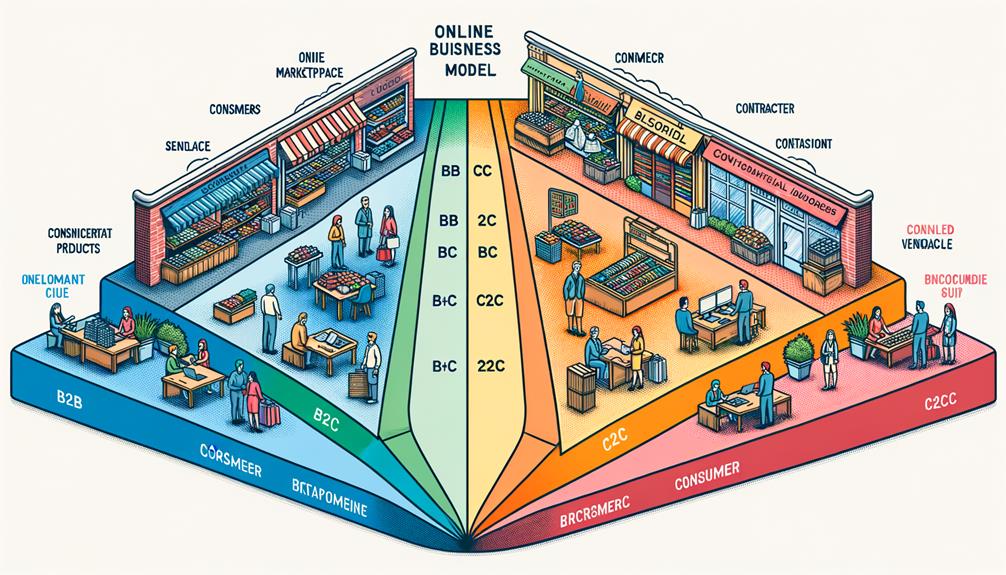As consumers, we have all experienced the convenience of online shopping, but have you ever stopped to consider the different ways in which businesses operate in the digital marketplace?
Well, get ready to embark on a journey of discovery as we delve into the world of ecommerce and explore the various business models that exist within this thriving industry.
From the widely known B2C model, where businesses sell directly to consumers, to the lesser-known B2B, B2B2C, B2G, and C2B models, there is a vast array of approaches that businesses can take to reach their target audience and deliver value.
So, whether you're a business owner looking to establish an online presence or simply curious about the inner workings of ecommerce, hold on tight as we uncover the intriguing world of ecommerce business models and the factors to consider when selecting the right model for your venture.
B2C Ecommerce Model
In the world of ecommerce, the B2C model stands out as a direct and dynamic approach to selling products and services to end-users. It's all about connecting businesses directly with consumers, eliminating the need for intermediaries.
With B2C, the decision-making process is shorter, allowing for quicker transactions. Additionally, marketing expenses and average order value tend to be lower compared to other models.
Technology plays a crucial role in B2C, enabling businesses to engage in direct customer marketing and build strong relationships. Whether it's selling physical products or offering services, B2C provides a platform for businesses to connect with their target audience in a more personal and efficient way.
This liberation-focused model empowers both businesses and consumers by facilitating direct transactions and fostering a sense of freedom in the online marketplace.
B2B Ecommerce Model
The B2B ecommerce model revolutionizes the way businesses sell their products and services by focusing on building strong relationships and targeting niche markets for success. Unlike B2C, which caters to individual consumers, B2B transactions occur between businesses, often involving larger order values and longer sales cycles.
One of the recent innovations in B2B ecommerce is the development of storefronts specifically designed for B2B selling. These platforms provide a seamless buying experience, with features like personalized pricing, bulk ordering, and customizable catalogs. Additionally, there's been a rise in B2B selling by millennials, who prioritize convenience and efficiency in their purchasing decisions.
B2B2C Ecommerce Model
Continuing our exploration of ecommerce business models, let's now dive into the intriguing world of the B2B2C model. This unique model involves partnerships with other organizations, where the end customers are aware of the original company. It's important to note that B2B2C is different from white labeling, as it requires collaboration between companies to reach end consumers.
Here are four key aspects to understand about the B2B2C ecommerce model:
- Collaboration: B2B2C relies on collaboration between businesses to deliver products or services to end consumers. This collaboration can involve joint marketing efforts, shared distribution channels, and even co-developed products.
- Expanded Reach: By partnering with other organizations, companies using the B2B2C model can tap into a wider customer base. This allows them to reach more potential customers and increase their market presence.
- Mutual Benefit: The B2B2C model is designed to benefit all parties involved. By working together, companies can leverage each other's strengths, resources, and expertise to create a win-win situation for everyone.
- Enhanced Customer Experience: With the B2B2C model, companies can provide a more seamless and integrated customer experience. By collaborating with other organizations, they can combine their products or services to offer a more comprehensive solution to the end customer.
The B2B2C ecommerce model offers a unique and innovative approach to reaching and serving customers. By leveraging partnerships and collaboration, companies can expand their reach, enhance the customer experience, and create mutually beneficial relationships.
B2G Ecommerce Model
Let's now explore the dynamic world of the B2G Ecommerce Model, where businesses sell their products directly to government entities, creating a secure and reliable business model. In this model, companies have the opportunity to provide goods and services to government agencies, such as federal, state, or local governments. Selling to the government can offer several advantages, including stable revenue streams and long-term contracts.
However, it's important to note that the B2G model comes with its own set of challenges. Government procurement processes can be complex and bureaucratic, which may lead to longer sales cycles. Additionally, businesses operating in the B2G space must comply with strict regulations and meet specific criteria to secure government contracts.
Despite these challenges, the B2G model can be highly lucrative for businesses that are able to navigate the government procurement landscape successfully. By understanding the unique needs and requirements of government entities, companies can position themselves as trusted partners and build long-term relationships with government buyers. This can result in a steady stream of business and the opportunity to make a significant impact in the public sector.
C2B Ecommerce Model
Occasionally, individuals have the power to sell their products and services to companies, creating a unique and empowering business model known as the C2B Ecommerce Model. This model flips the traditional B2C dynamic on its head, giving consumers the upper hand in the marketplace.
Here's how the C2B Ecommerce Model works:
- Pricing Power for Consumers: In the C2B model, individuals have the freedom to set their own prices for the products and services they offer. This puts consumers in control, allowing them to demand fair compensation for their offerings.
- Companies Compete to Meet Consumer Needs: Instead of companies dictating what's available in the market, the C2B model allows consumers to define their needs and preferences. Companies then compete to meet these demands, resulting in a more customer-centric approach.
- Examples Include Work Bidding Platforms and Affiliate Marketing: C2B platforms like freelancer websites or affiliate marketing programs enable individuals to showcase their skills or promote products and services they believe in. This gives them the opportunity to monetize their expertise and influence.
- Creative Use of Social Media Influencers for Marketing: Social media influencers have become powerful players in the C2B Ecommerce Model. They leverage their large followings to endorse products and services, influencing consumer behavior and driving sales.
The C2B Ecommerce Model empowers individuals to take control of their own economic destiny by selling their products and services to companies. It provides a platform for consumers to demand fair compensation, puts the power in their hands, and allows for creative and innovative ways to monetize their skills and influence.
Liberation is at the core of this model, giving individuals the freedom to shape their own success in the digital marketplace.
Characteristics of B2C, B2B, B2B2C, B2G, and C2B Models
The characteristics of B2C, B2B, B2B2C, B2G, and C2B models distinguish the various ways in which businesses interact with consumers, other businesses, and government entities in the ecommerce landscape.
B2C, or business-to-consumer, involves direct selling to end-users. This model has a shorter decision-making process and lower marketing expenses and average order value.
B2B, or business-to-business, focuses on selling to other businesses. It has a longer sales cycle but higher-order value, and recent innovations in ecommerce storefronts have made it more accessible.
B2B2C, or business-to-business-to-consumer, involves partnerships with other organizations. End customers are aware of the original company, and joint marketing efforts are made for mutual benefit.
B2G, or business-to-government, refers to selling products to government entities. It relies on successful bidding of government contracts and has a slower pace due to the bureaucratic nature.
C2B, or consumer-to-business, occurs when individuals sell to companies. It gives consumers pricing power and allows companies to compete to meet consumer needs.
Value Delivery Methods for Ecommerce Innovation
After understanding the characteristics of B2C, B2B, B2B2C, B2G, and C2B models, we can now explore the value delivery methods for ecommerce innovation.
- White label: This method involves branding and selling a product under its own name, allowing companies to boost their brand visibility while minimizing manufacturing costs. It's particularly popular in the fashion and cosmetics industries.
- Private label: With this approach, a retailer gets a product produced by a third party and sells it under its own brand name. The retailer has control over all aspects of the product, creating the perception that it's their own brand.
- Wholesaling: This method involves selling products in bulk and at a discount to other businesses. Wholesalers act as intermediaries between manufacturers and distributors/retailers, providing an efficient way to distribute products to retailers.
- Dropshipping: Market and sell items fulfilled by a third-party supplier. It acts as a middleman between buyers and manufacturers, allowing for easy integration of inventory from suppliers worldwide. This method offers a wide range of products without the need for inventory management.
These value delivery methods offer innovative approaches for ecommerce businesses to reach their customers and maximize their success.
White Label Ecommerce Model
We are going to delve into the exciting world of the White Label Ecommerce Model, a game-changing approach for businesses to establish their brand presence and drive success in the digital marketplace.
With this model, companies can brand and sell a product under their own name, increasing brand visibility while minimizing manufacturing costs. This method is particularly popular in the fashion and cosmetics industries.
By utilizing white labeling, businesses can focus on marketing and customer acquisition, leaving the manufacturing aspect to specialized third-party providers. This allows for a faster time to market and the ability to quickly scale operations.
With the White Label Ecommerce Model, businesses can build a strong brand presence and offer unique products without the need for extensive manufacturing capabilities. It's a liberating approach that empowers companies to create their own identity in the competitive ecommerce landscape.
Private Label Ecommerce Model
With the Private Label Ecommerce Model, businesses have the opportunity to create their own brand identity and control all aspects of the product, resulting in increased control and flexibility in the marketplace. Here are four reasons why this model is appealing for those seeking liberation:
- Brand Ownership: By creating their own brand, businesses can establish a unique identity and differentiate themselves from competitors. This allows for greater control over the brand image and customer perception.
- Product Control: With private labeling, businesses have the freedom to customize the product to meet their specific requirements and target audience. This enables them to offer unique features, packaging, and pricing strategies.
- Profit Margin: Private label products often have higher profit margins compared to reselling other brands. By eliminating the middleman and controlling the entire supply chain, businesses can reduce costs and increase profitability.
- Flexibility and Scalability: Private labeling allows businesses to adapt quickly to market trends and consumer demands. They can easily introduce new products or make changes to existing ones, providing the flexibility to stay competitive and grow their business.
Factors to Consider in Selecting an Ecommerce Business Model
When selecting an ecommerce business model, it's crucial to carefully consider various factors that will ultimately impact the success and profitability of your online venture. Understanding the expectations and behaviors of your customers is key. By identifying their pain points in the current market and finding ways to improve them, you can create a business model that meets their needs and sets you apart from the competition.
Innovation is also vital in improving customer relations and overall satisfaction. By continuously finding new ways to engage with your customers and provide them with a unique experience, you can build a loyal customer base.
Additionally, it's important to build your business around your existing strengths. By leveraging your skills, expertise, and resources, you can create a business model that aligns with your capabilities and gives you a competitive advantage.
Lastly, consider different business models based on your product and goals. Whether you're selling physical products, digital goods, or services, choose a model that best suits your offering and helps you achieve your objectives.
Frequently Asked Questions
How Can B2C Ecommerce Models Leverage Technology for Direct Customer Marketing?
B2C ecommerce models can leverage technology for direct customer marketing by utilizing various digital tools and platforms. These include personalized email marketing, targeted advertising on social media, and the use of customer data for segmentation and personalization.
By harnessing technology, B2C businesses can reach their target audience more effectively, tailor their marketing messages to individual customers, and provide a seamless and personalized shopping experience.
This ultimately leads to increased customer engagement, higher conversion rates, and improved customer satisfaction.
What Are Some Recent Innovations in Ecommerce Storefronts for B2B Models?
In recent years, there have been several exciting innovations in ecommerce storefronts for B2B models.
These include the development of user-friendly interfaces that cater to the specific needs of businesses, enhanced customization options for products and services, and the integration of advanced analytics and data-driven insights to improve decision-making processes.
Additionally, there's been a rise in the use of artificial intelligence and machine learning technologies to automate tasks and streamline operations.
These innovations have revolutionized the B2B ecommerce landscape, making it easier and more efficient for businesses to connect and transact with one another.
How Is B2B2C Different From White Labeling in Terms of Reaching End Consumers?
B2B2C is different from white labeling in terms of reaching end consumers because it involves collaborations with other organizations to reach the customers.
With B2B2C, the end customers are aware of the original company and there are joint marketing efforts for mutual benefit.
On the other hand, white labeling is about branding and selling a product under its own name, without the involvement of other organizations.
B2B2C allows for a wider reach and greater visibility, while white labeling focuses on building brand recognition.
What Are the Limitations in Potential Revenue Streams for B2G Ecommerce Models?
The limitations in potential revenue streams for B2G ecommerce models include a slower pace due to bureaucratic nature and the reliance on successful bidding of government contracts. While B2G models offer a more secure business model, the revenue may be limited compared to other ecommerce models.
However, with effective strategies and targeting the right government entities, B2G ecommerce can still be a profitable venture. It's important to understand these limitations and consider them when selecting an ecommerce business model.
How Do Companies Compete to Meet Consumer Needs in C2B Ecommerce Models?
In a C2B ecommerce model, companies compete to meet consumer needs by giving individuals pricing power. Consumers have the ability to set their desired price and companies then compete to fulfill those needs.
This allows for a more customer-centric approach, where companies must be responsive and adaptable to the demands of the consumers. It also encourages innovation and creativity in meeting consumer expectations.
Conclusion
In conclusion, understanding the different types of ecommerce business models is essential for anyone looking to thrive in this digital marketplace. Whether you're a business owner or simply curious about the inner workings of ecommerce, knowing the unique characteristics and value delivery methods of B2C, B2B, B2B2C, B2G, and C2B models is crucial.
Additionally, considering factors such as scalability, target audience, and product offering will help you select the right ecommerce business model for your venture.
Stay informed and dive into the exciting world of ecommerce!



